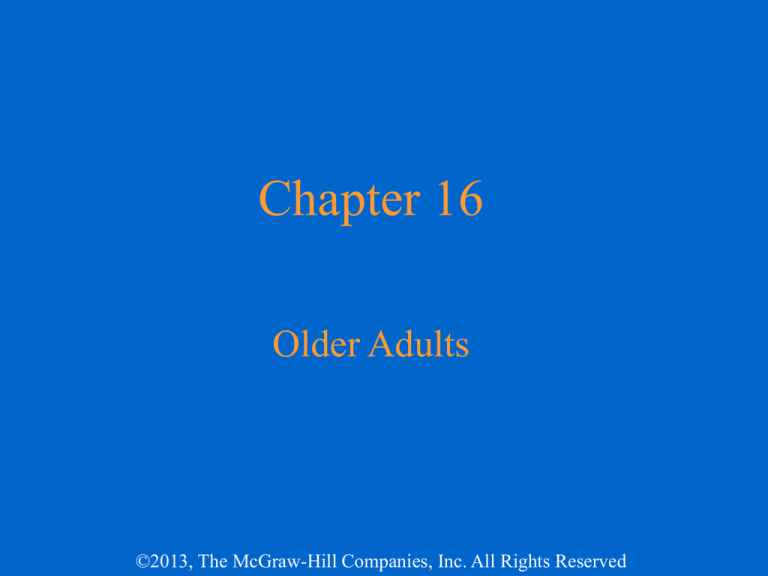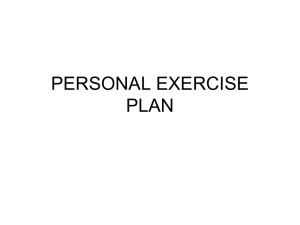
Chapter 16
Older Adults
©2013, The McGraw-Hill Companies, Inc. All Rights Reserved
Chapter Objectives
After completing this chapter, you should be able to
1. Define functional fitness.
2. State why functional fitness of older adults should be
measured.
3. Describe the pretest/pre-activity screening process for
older adults.
4. Measure the functional fitness of older adults.
5. Describe responsibilities after measurement of
functional fitness of older adults and prescribe activities
and exercise for the development of functional fitness
for the older adult.
©2013, The McGraw-Hill Companies, Inc. All Rights Reserved
16-2
Functional Fitness
Functional fitness is the physical capacity of the
individual to perform ordinary daily activities safely and
independently without undue fatigue.
By year 2020, nearly 20% of the U.S. population will be 65
or older.
Will have greater number of individuals age 85 and older.
Can expect an increase in the number of individuals who
are unable to function effectively.
©2013, The McGraw-Hill Companies, Inc. All Rights Reserved
16-3
Why Measure Functional Fitness?
Sedentary lifestyle often directly related to
chronic diseases associated with aging.
Activity level of many individuals declines with
age.
Much of the age-related physical decline in older
years may be prevented through an active
lifestyle; must encourage older population to be
physically active.
Important for older individuals to identify any
physical limitations that could place them at risk
before they initiate active lifestyle.
©2013, The McGraw-Hill Companies, Inc. All Rights Reserved
16-4
Why Measure Functional Fitness?
In addition, proper measure and assessment can
serve to:
• identify physical weakness or deficiencies that
will limit success with the initiation of an active
lifestyle
• identify physical abilities in which further decline
may be prevented or reduced
• provide a baseline for evaluating improvement in
physical performance
©2013, The McGraw-Hill Companies, Inc. All Rights Reserved
16-5
Why Measure Functional Fitness?
In addition, proper measure and assessment can
serve to:
• provide feedback to individuals about their
limitations and motivate them to initiate an active
lifestyle
• provide data for evaluation of program
effectiveness
©2013, The McGraw-Hill Companies, Inc. All Rights Reserved
16-6
Responsibilities after Measurement
Challenge – design appropriate physical activity
program that will improve functional fitness
(cardiorespiratory fitness, muscular strength and
endurance, flexibility, agility, and balance)
You will probably find wide variations of
functional fitness in group of older adults.
©2013, The McGraw-Hill Companies, Inc. All Rights Reserved
16-7
Responsibilities after Measurement
You must consider individual differences in health
status, physical fitness, and previous lifestyle.
No exercise or activity guidelines that can be
applied to all older adults; only general guidelines
(described at conclusion of chapter).
©2013, The McGraw-Hill Companies, Inc. All Rights Reserved
16-8
Testing Guidelines
Pretest/pre-activity screening somewhat different
than screening for younger adults.
Should administer activity readiness questionnaire
such as Physical Activity Readiness Questionnaire
(PAR-Q)
©2013, The McGraw-Hill Companies, Inc. All Rights Reserved
16-9
Testing Guidelines
Cooper Institute recommends you ask older adult
test participants to:
• walk about 8 feet
• stand and sit in a chair several times
• reach upward, backward and across the body
• flex and extend the knee
• rotate the feet at the ankle joints
• hold and work with small objects
• stand while you observe their posture
©2013, The McGraw-Hill Companies, Inc. All Rights Reserved
16-10
Testing Guidelines
As test participants perform, ask them to
comment on their level of discomfort.
Index of Pain
1. Little or no joint discomfort
2. Mild joint discomfort
3. Moderate joint discomfort
4. Severe joint pain
5. Too painful to perform movement
©2013, The McGraw-Hill Companies, Inc. All Rights Reserved
16-11
Tests of Functional Fitness
Many older individuals are capable of completing
some of the physical performance tests items
presented in other chapters.
The ACSM Fitness Test, the Canadian Physical y
Fitness & Lifestyle Approach, and the YMCA
Fitness Test include norms for adults sixty and
over.
Some individuals will be better served by
attempting the items presented in this chapter.
©2013, The McGraw-Hill Companies, Inc. All Rights Reserved
16-12
Functional Fitness Assessment for Adults
Over 60 Years
Test Objective. To evaluate the ability of adults to
carry on certain daily activities.
Age level. Over sixty.
Validity assumed for ponderal index, sit and reach,
and agility course; coefficients reported for other
items.
Reliability coefficients reported.
Table 16.1 reports average standard for ages sixty
through ninety.
©2013, The McGraw-Hill Companies, Inc. All Rights Reserved
16-13
Functional Fitness Assessment for Adults
Over 60 Years
Test Components
1. Ponderal index: Figure 16.1 is used to
determine index.
2. Trunk/leg flexibility: Sit and reach
3. Agility.dynamic balance: Figure 16.2
illustrates the course.
©2013, The McGraw-Hill Companies, Inc. All Rights Reserved
16-14
Figure 16.2 Agility course.
©2013, The McGraw-Hill Companies, Inc. All Rights Reserved
16-15
Functional Fitness Assessment for Adults
Over 60 Years
Test Components
4. Coordination: Soda can test.
5. Strength/endurance: A 4-pound weight is used
for women, and an 8-pound weight is used for
men.
©2013, The McGraw-Hill Companies, Inc. All Rights Reserved
16-16
Functional Fitness Assessment for Adults
Over 60 Years
6. Aerobic fitness: 880-yard walk. Individuals
with the following conditions should consult
their physician before attempting this item.
• Significant orthopedic problems that may be
aggravated by prolonged continuous walking.
• History of cardiac problems that can be
negatively influenced by physical exertion.
• Lightheadedness while physically active or
history of uncontrolled hypertension.
©2013, The McGraw-Hill Companies, Inc. All Rights Reserved
16-17
Functional Fitness Test for CommunityResiding Older Adults (Senior Fitness Test)
Test Objective. To assess the major underlying
physical parameters associated with functional
mobility in independent older adults.
Age level. Sixty to ninety-plus.
Validity coefficients reported for 30-second chair
stand, arm-curl, 6-minute walk, and chair sit and
reach. Face validity was accepted for the back
scratch and 8-foot up-and-go.
Reliability coefficients reported.
©2013, The McGraw-Hill Companies, Inc. All Rights Reserved
16-18
Functional Fitness Test for CommunityResiding Older Adults
Table 16.2 reports percentile norms for ages sixty
through ninety-four.
Test Components
1. Lower body strength: 30-second chair stand.
2. Upper body strength: Arm curl. A 5-pound
dumbbell is used for women, and an 8pound dumbbell is used for men.
3. Aerobic endurance: Two options – 6-minute
walk and 2-minute step-in-place.
©2013, The McGraw-Hill Companies, Inc. All Rights Reserved
16-19
Functional Fitness Test for CommunityResiding Older Adults
Test Components
4. Lower body flexibility (hamstrings): Chair sit
and reach.
5. Upper body (shoulder) flexibility: Back scratch.
6. Agility/dynamic balance: 8-foot up-and-go.
7. Body composition: Body mass index.
©2013, The McGraw-Hill Companies, Inc. All Rights Reserved
16-20
Physical Fitness Assessment of Older
Adults
Cooper Institute uses this test to measure healthrelated fitness rather than functional fitness. With
exception of one mile walk, components similar
to two tests described previously.
Test objective. Assess health-related components
of fitness and establish baseline score.
Age level. Forty to seventy-nine.
©2013, The McGraw-Hill Companies, Inc. All Rights Reserved
16-21
Physical Fitness Assessment of Older
Adults
Validity and reliability not reported but items
similar to items for which validity and reliability
have been reported.
Table 16.3 reports average standards for sixty
through seventy-nine.
©2013, The McGraw-Hill Companies, Inc. All Rights Reserved
16-22
Physical Fitness Assessment of Older
Adults
Test Components
1. Aerobic capacity: One mile walk.
2. Muscular strength: Hand grip test.
3. Upper body muscular endurance: Arm
curls.
4. Lower body muscular endurance: Lower leg
extension.
5. Trunk and leg flexibility: Sit and reach test.
6. Shoulder flexibility: Back scratch.
7. Body composition: BMI and waist
circumference.
©2013, The McGraw-Hill Companies, Inc. All Rights Reserved
16-23
Functional Assessments - Frail
Battery of tests used to assess simple skills used
in daily living. First trial serves as baseline
score; subsequent tests show increases, decreases,
or maintenance of the skill.
Age level. For any adult who appears to have lost
some mobility and functionality.
©2013, The McGraw-Hill Companies, Inc. All Rights Reserved
16-24
Functional Assessments - Frail
Test Components
1. Lower body strength: Chair stand.
2. Strength and endurance: Stair climb.
3. Functional mobility and habitual gait speed: 6
meter gait walk.
4. Balance and flexibility: Reaching up.
5. Position change: Bending.
6. Balance: Stance positions.
7. Upper body strength and endurance:
Wheelchair mobility.
©2013, The McGraw-Hill Companies, Inc. All Rights Reserved
16-25
Physical Activity for the Older Adult
For the older adult, physical activity includes all
movements associated with everyday life (e.g.,
work , routine activities, exercise activities, and
recreational activities.
Older adult can experience the benefits of physical
activity in much the same way as younger
individuals.
©2013, The McGraw-Hill Companies, Inc. All Rights Reserved
16-26
Physical Activity for the Older Adult
With an active lifestyle, older adults:
• have a better self image
• sleep better
• maintain appropriate body composition
• have better muscle tone and strength and
maintain bone mass
©2013, The McGraw-Hill Companies, Inc. All Rights Reserved
16-27
Physical Activity for the Older Adult
With an active lifestyle, older adults:
• better manage stress
• are more likely to have a positive attitude and
less depression
• experience fewer minor infectious ailments
• have more frequent bowel movements (less
constipation
©2013, The McGraw-Hill Companies, Inc. All Rights Reserved
16-28
Physical Activity for the Older Adult
Over the long term, the benefits of an active
lifestyle include:
• continuation of immediate benefits
• increased cardiorespiratory endurance
• increased muscle strength and endurance
• increased flexibility
©2013, The McGraw-Hill Companies, Inc. All Rights Reserved
16-29
Physical Activity for the Older Adult
Over the long term, the benefits of an active
lifestyle include:
• prevention of bone loss, decreased risk of
osteoporosis
• prevention and/or postponement of declines in
balance and coordination
• postponement of decline in speed of movement
and reaction time
• improved mental health
©2013, The McGraw-Hill Companies, Inc. All Rights Reserved
16-30
Physical Activity for the Older Adult
For most older adults, physical activity of mild to
moderate intensity is not dangerous.
Some individuals should consult a physician before
increasing their physical activity.
ACSM’s Health-Related Physical Fitness
Assessment (2010) and PAR-Q & YOU in figure
11.1 provide a list of questions that will help
individuals determine whether medical clearance
should be obtained before they increase their
physical activity.
©2013, The McGraw-Hill Companies, Inc. All Rights Reserved
16-31
Physical Activity for the Older Adult
Individual differences must be considered but
general exercise guidelines for aerobic activities
are:
Activity
Large-muscle, rhythmic activities provide
cardiorespiratory benefits – bicycling, jogging,
swimming, walking
©2013, The McGraw-Hill Companies, Inc. All Rights Reserved
16-32
Physical Activity for the Older Adult
General exercise guidelines for aerobic activities:
Frequency
The activities should be performed a minimum of
two or three times a week. After a period of
adjustment, most individuals are able to exercise
4 to 6 days a week.
©2013, The McGraw-Hill Companies, Inc. All Rights Reserved
16-33
Physical Activity for the Older Adult
General exercise guidelines for aerobic activities:
Duration
Typical exercise session would be:
warm-up and stretching: 10 to 20 minutes
aerobic activity: 25 to 30 minutes
cool down: 5 to 10 minutes
©2013, The McGraw-Hill Companies, Inc. All Rights Reserved
16-34
Physical Activity for the Older Adult
General exercise guidelines for aerobic
activities:
Intensity
Low to moderate and related to the
functional capacity of individual
©2013, The McGraw-Hill Companies, Inc. All Rights Reserved
16-35
Physical Activity for the Older Adult
Flexibility and muscular fitness exercises should
be included.
Should be related to functional capacity of
individual.
Best to avoid the use of rigid guidelines when
prescribing exercise for older adult.
Many sedentary individuals can experience
health benefits through 10- to 15-minute
segments of mild activity.
©2013, The McGraw-Hill Companies, Inc. All Rights Reserved
16-36






